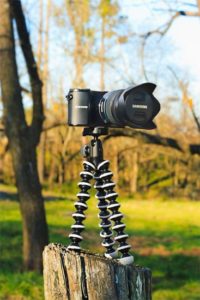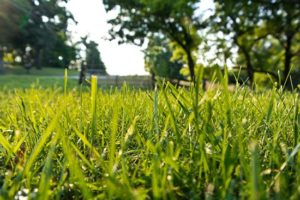
Design: Samsung has designed the NX200 to be quite sexy. Having an all black metal body, and what really stands out is the smooth curved textured grip on the right side. They have also packed in 2 scroll wheels. One on the top and one on the back, for changing settings and navigating your photos. On the top you’ll find a full hotshoe. Which can be used for the included external flash, or a transmitter when using off camera flash. Look on the bottom, and you’ll find the battery and SD card compartment. Under the plastic door on the left is where you’ll find the HDMI and USB ports. Last but not least is the 3” gorgeous AMOLED screen, which takes up the majority of the back of the camera. It’s bright, vivid, has deep blacks and works great outdoors.
 Handling: The curve and texture of the grip feel good in the hand, but the thinness of the body hurts it here. Making it difficult to hold one handed or pick up with one hand, without smashing most of the buttons on the back of the body. When holding with 2 hands though it’s very comfortable. While the NX200 offers up a beautiful screen with rich blacks and colors, you’ll still find yourself missing a viewfinder in certain situations. For instance when shooting moving subjects. Unfortunately they do not offer an electronic viewfinder for the NX200. One more thing you’ll find missing, is anyway to tether the NX200 to a computer. There is also no way to remotely trigger the shutter. All features you may have become accustomed to if you own a DSLR. I also found the arrow keys difficult to push, which are located within the scroll wheel on the back of the camera. Users with big fingers beware.
Handling: The curve and texture of the grip feel good in the hand, but the thinness of the body hurts it here. Making it difficult to hold one handed or pick up with one hand, without smashing most of the buttons on the back of the body. When holding with 2 hands though it’s very comfortable. While the NX200 offers up a beautiful screen with rich blacks and colors, you’ll still find yourself missing a viewfinder in certain situations. For instance when shooting moving subjects. Unfortunately they do not offer an electronic viewfinder for the NX200. One more thing you’ll find missing, is anyway to tether the NX200 to a computer. There is also no way to remotely trigger the shutter. All features you may have become accustomed to if you own a DSLR. I also found the arrow keys difficult to push, which are located within the scroll wheel on the back of the camera. Users with big fingers beware.
Menus: The menu system is very visual and gorgeous. They really put a lot of styling into the menus, and made the camera a pleasure to use. You can easily navigate through the menus using the scroll wheels on the top and back. It even includes a tip overlay to help you understand the settings better, and what they do. The Fn button is undoubtedly the most useful button on the camera. Push it and it’ll bring up the screen with all of the shooting settings. Allowing you to quickly get an overview of every setting and make changes. Using the back scroll wheel to move to the setting, and the top one to make any changes.
Lens: The NX200 comes with an 18-55mm f/3.5-5.6 kit lens that is optically stabilized. It’s just as good as any kit lens you’ll find, if not better. You’ll find there is some chromatic aberration at the widest zoom. Overall though the lens is capable of producing great images. Just like with other mirrorless cameras, you’ll find the lens is so big it makes it less compact and a little awkward. If paired with one of their pancake lenses though, you’ll find it’s a perfect match, making it a high quality compact system for shooting. The kit lens also comes with i-Function, which is where Samsung really finds a way to stand out from the pack. The i-Function button on the lens allows you change common camera settings, using the zoom ring. Settings such as aperture, shutter speed, iso, exposure value, and white balance can all be assigned to the i-Function button.
Picture Quality: The photos produced by the NX200 are quite stunning. Samsung has packed a 20.3mp full sized APS-C sized sensor, that rivals any mid range DSLR on the market. You can shoot in raw or jpg, and up to 7fps. The colors are bright and vibrant, and performs well at higher isos. The NX200 has an iso range from 100-12,800, and handles noise exceptionally well until you reach iso 6400. At iso 6400 and above is where noise becomes most noticeable. As long as you are shooting below iso 6400, you’ll be quite pleased with the images. Which is good news, because the external flash adds more bulk to the camera. You’ll find yourself not carrying it most of the time, and will appreciate how well it performs at higher isos.
However the raw files produced are quite large. Even after the latest firmware update 1.04 they are on average 30mb a piece. Meaning after downloading to the computer, you’ll most likely want to take an extra step of converting to Adobe DNG files. This reduces the file size to a much more manageable 15-20mb per image.
For those of you who enjoy adding effects to your images ala Instagram, Hipstamatic, Snapseed, etc. You’ll enjoy playing with Magic Frames and Smart Filters. They allow you to apply a handful of effects and frames to your photos, in jpg only.
Conclusion: Despite its faults, the gorgeous screen and high quality sensor should win you over. Samsung has made quite an impressive camera. It makes a perfect camera for landscapes, street photography, or still life. It performs so well and in such a compact body, making it easy to carry and giving you the high quality images you’re after. I’m in love with the images it produces, and find myself using it as much as possible.
–
![]()
 Jason England
Jason England
Amateur photographer out of Knoxville, TN.
http://www.flickr.com/photos/slyphotography/
Here’s how you can share your tips, techniques and tutorials on CurrentPhotographer.com
–
*The Current Photographer website contains links to our affiliate partners. Purchasing products and services through these links helps support our efforts to bring you the quality information you love and there’s no additional cost to you.

